
Burn cabin, after the family moved
to Waldron Island. Photo Credit: Seattle Times
IN 1919, A NEWLYWED COUPLE CLAIMED A HOMESTEAD AMONG THE FAR SAN JUAN ISLANDS,
retiring, as they put it, when they were still young enough to enjoy their freedom. Living in a canvas tent,
alone on their island, they sunned naked on the rocks and talked the nights away by the red flames of
driftwood fires. They agreed: Their lives would be a series of adventures.
June Burn and her easygoing husband, Farrar, lived the dream. With new baby North,
they ventured cross-country in a donkey cart, selling songs to pay their way. Later, she and her
second son, South, took off on a hiking trip through the West, meeting hoboes and singers,
beggars and thieves. When you're driving, you're never there, she explained in "Living High,"
her autobiography, but when you're walking, you are always there.
When June briefly taught at the University of Washington,
Times society editor Virginia Boren visited her cramped little digs in the U. District.
In a gloved-and-hatted era, June was at her glowing best in sneakers, jeans and a castoff sweater.
Puzzled but charmed, Boren jotted notes as June chatted of Madrona trees and clam digs.
At the interview's end, June spread out her treasure -- a collection of tide-polished beach pebbles --
and invited the journalist to choose one, for keeps.
Farrar once ruefully confessed, "I guess we'll be amateurs at everything until we die,
(but) you know a man can't have any more than this. The earth, this sea, a beach,
food, companionship. This is all any man can get." Perched on the windswept coast,
June and Farrar Burn lived on the very margins of Northwest society, but her prose welcomed island dreamers.